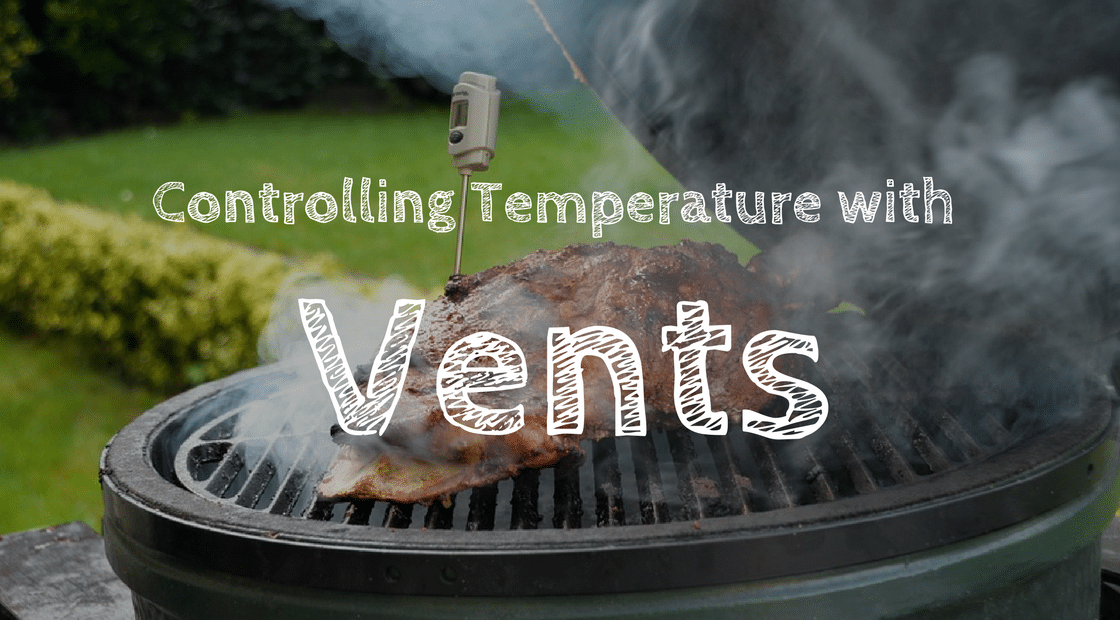Wood and charcoal grills are notoriously volatile. So let us show you some techniques to Control Temperature with Vents.
Many grillers think of wood and charcoal grills as wild animals, with minds and a will of its own. Flames and heat licking up and destroying the food at it’s own convenience or simply not providing enough heat to cook the food through.
Fortunately, this is an animal that can be tamed. By just understanding what is going on in the grill we can develop strategies to control the temperature.
What Fuels a Charcoal or Wood Grill?
This is the part that escapes a lot of people: What fuels the grill?
Well, the answer we get back is usually: “Charcoal or wood, obviously”.
And, yes, that is true. But, we are missing an important factor, the oxygen. Oxygen also acts as a fuel and that’s where the control comes in.
There are two ways to control the heat, either control the charcoal/ wood or control the oxygen.
What we are going to talk about today is using the vents to control the temperature of the grill by decreasing or increasing the amount of oxygen feeding the fire.
https://www.instagram.com/p/BScHKofBjEB/?taken-by=grillmastersclubvip
Keeping the Lid Down
The first thing that you will want to do if you are going to control the temperature is to cook with the lid down.
The reason for this is that if you are cooking without a lid on the grill then it is impossible to control the level of oxygen entering the grill and the gases leaving the grill.
Two Types of Vents
As I mentioned above there are two types of vents, one to take in oxygen to feed the fire and one to get rid of the gases.
The Lower Vent or Intake Damper
The intake damper is usually positioned on the bottom or underside of the grill. Oxygen enters through this lower vent and fuels the charcoal or wood.
Fire needs oxygen to continue burning. If you close off the supply then the fire will simply burn out.
The more you open this vent, the more oxygen (or fuel for the fire) will enter the grill and the temperatures will soar.
More often than not, this will be the main way you will control the heat of the grill - by either closing the vent more to reduce oxygen levels and decreasing temperature or opening the vent wider to increase oxygen flow and temperatures.
The Lid Vent or Exhaust Damper
Much the same as the intake damper, the exhaust damper cannot be closed for any period of time otherwise gases like Carbon Monoxide and Carbon Dioxide will build up within the grill and starve the fire of much needed oxygen required to keep burning.
However, the exhaust damper does not only release the gases and smoke, it also serves the dual function of leaving a gap that needs to be filled. This creates an airflow where the gas is released from the exhaust damper, more oxygen is pulled in through the intake damper to fill the vacuum.
Understanding Your Grill
In order to understand the temperature of your grill you need to be scientific and treat it as an experiment. In order to truly understand what works and what doesn’t we can only change one thing at a time.
So, I would recommend understanding the intake damper first. Leave the lid vent open completely and record what temperatures you reach at various stages of having the lower vent open (e.g. quarter open, half open, three quarters open and fully open),
It is also a great idea to look to your favorite recipes. What temperatures do they call for? Try and figure out, using the lower vent, how you can reach those temperatures for a sustained period of time.
Make sure that you record the set-up (i.e. how much wood/ charcoal you have added and the position of both vents).
https://www.instagram.com/p/BR6ozotBnoU/?taken-by=grillmastersclubvip
Summing things Up
Using these methods and being careful to record the set-up and position of your vents will make it much easier to follow any recipes that specify temperature or will simply afford you more control over the cooking temperature.
If, through experimentation, you are unable to find the temperature that you require there could be two further reasons that we will cover at a later date. These are the amount of wood/ charcoal itself and the possibility of leaks in your grill if the lid does not fit tightly into the base.
Let us know on Twitter, Facebook or Instagram how your grilling is going and if you have any questions about using the vents to control heat on your wood or charcoal grill send us a message!









